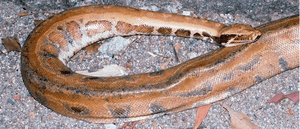Myanmar short-tailed python facts for kids
Quick facts for kids Myanmar short-tailed python |
|
|---|---|
 |
|
| Conservation status | |
| Scientific classification | |
| Genus: |
Python
|
| Species: |
kyaiktiyo
|
The Python kyaiktiyo, also known as the Myanmar short-tailed python, is a special type of python. It lives only in Myanmar. Scientists have only found a few of these snakes. It is known from a single specimen found in Yetagon Myaung, which is about 390 meters (1,280 feet) above sea level. Since 2012, this python has been listed as a Vulnerable animal. This means it needs protection because its numbers are low.
Discovering the Myanmar Short-tailed Python
The Myanmar short-tailed python was first officially described in 2011. Three scientists, George R. Zug, Steve W. Gotte, and Jeremy F. Jacobs, gave it its scientific name. They studied a female snake found in the Kyaikhtiyo Wildlife Sanctuary in 2002. This snake had special features that made it different from other pythons. Because it was so unique, and lived in its own area, scientists decided it was a brand new species. It is different from its closest relative, the blood python.
What Does It Look Like?
The Myanmar short-tailed python is a snake that squeezes its prey. It is not venomous, so it does not have poisonous fangs. This python can grow up to about 6 feet (1.8 meters) long. The first female found was 152 centimeters (5 feet) long and weighed 3.6 kilograms (8 pounds).
These pythons have a light brown body with rusty colored stripes and blotches. They also have dark brown to black spots all along their body. Their scales are smooth. Like most pythons, they have special "facial pits" on their face. These pits help them sense heat, which is useful for finding prey in the dark. They mostly live on the ground. The Myanmar short-tailed python is part of a group called "short-tailed pythons." It is special because it has a very large number of belly scales, 180 or more.
Where Do They Live?
The Python kyaiktiyo is believed to live only in the Tenghyo Range in Mon State, Myanmar. However, it is very rare to see them in this area. This makes them even more special and important to protect.


